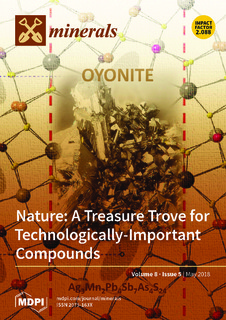| dc.contributor.author | Müller, Axel | |
| dc.contributor.author | Ganerød, Morgan | |
| dc.contributor.author | Wiedenbeck, Michael | |
| dc.contributor.author | Spjelkavik, Skule Olaus Svendsen | |
| dc.contributor.author | Selbekk, Rune | |
| dc.date.accessioned | 2019-03-20T14:37:25Z | |
| dc.date.available | 2019-03-20T14:37:25Z | |
| dc.date.created | 2019-01-13T18:41:07Z | |
| dc.date.issued | 2018 | |
| dc.identifier.citation | Minerals. 2018, 8 (5), 175. | nb_NO |
| dc.identifier.issn | 2075-163X | |
| dc.identifier.uri | http://hdl.handle.net/11250/2590920 | |
| dc.description.abstract | The quartz-K-feldspar-cemented breccia of Berglia-Glassberget in the Lierne municipality in central Norway forms an ellipsoid structure 250 m × 500 m in size. The hydrothermal breccia is barren in terms of economic commodities but famous among mineral collectors for being a large and rich site of crystal quartz of various colours and habits. Despite being a famous collector site, the mineralization is rather unique in respect to its geological setting. It occurs within Late Palaeoproterozoic metarhyolites of the Lower Allochthon of the Norwegian Caledonides regionally isolated from any other contemporaneous hydrothermal or magmatic event. In order to understand better the formation of the Berglia-Glassberget breccia, the chemistry, fluid inclusion petrography and age of the breccia cement were determined. Structural features indicate that the Berglia-Glassberget is a fault-related, fluid-assisted, hydraulic breccia which formed by single pulse stress released by a seismic event. 40Ar-39Ar dating of K-feldspar cement revealed a middle Triassic age (240.3 ± 0.4 Ma) for this event. The influx into the fault zone of an aqueous CO2-bearing fluid triggered the sudden fault movement. The high percentage of open space in the breccia fractures with cavities up 3 m × 3 m × 4 m in size, fluid inclusion microthermometry, and trace element chemistry of quartz suggests that the breccia was formed at depths between 4 and 0.5 km (1.1 to 0.1 kbar). The origin of the breccia-cementing, CO2-bearing Na-HCO3-SO4 fluid may have been predominantly of metamorphic origin due to decarbonation reactions (T > 200 °C) of limestones of the underlying Olden Nappe. The decarbonation reactions were initiated by deeply derived, hot fluids channelled to sub-surface levels by a major fault zone, implying that the breccia is situated on a deep-seated structure. Regionally, the Berglia-Glassberget occurs at a supposed triple junction of long-lived fault zones belonging to the Møre-Trøndelag, Lærdal-Gjende and the Kollstraumen fault complexes. These fault systems and the associated Berglia-Glassberget earthquake are the expression of rifting and faulting in northern Europe during the middle/late Triassic. | nb_NO |
| dc.language.iso | eng | nb_NO |
| dc.publisher | MDPI | nb_NO |
| dc.rights | Navngivelse 4.0 Internasjonal | * |
| dc.rights.uri | http://creativecommons.org/licenses/by/4.0/deed.no | * |
| dc.title | The Hydrothermal Breccia of Berglia-Glassberget, Trøndelag, Norway: Snapshot of a Triassic Earthquake | nb_NO |
| dc.type | Journal article | nb_NO |
| dc.type | Peer reviewed | nb_NO |
| dc.description.version | publishedVersion | nb_NO |
| dc.source.pagenumber | 32 | nb_NO |
| dc.source.volume | 8 | nb_NO |
| dc.source.journal | Minerals | nb_NO |
| dc.source.issue | 5 | nb_NO |
| dc.identifier.doi | 10.3390/min8050175 | |
| dc.identifier.cristin | 1655692 | |
| dc.description.localcode | © 2018 by the authors. Licensee MDPI, Basel, Switzerland. This article is an open access article distributed under the terms and conditions of the Creative Commons Attribution (CC BY) license (http://creativecommons.org/licenses/by/4.0/). | nb_NO |
| cristin.unitcode | 194,31,5,0 | |
| cristin.unitname | Institutt for arkeologi og kulturhistorie | |
| cristin.ispublished | true | |
| cristin.fulltext | original | |
| cristin.qualitycode | 1 | |

